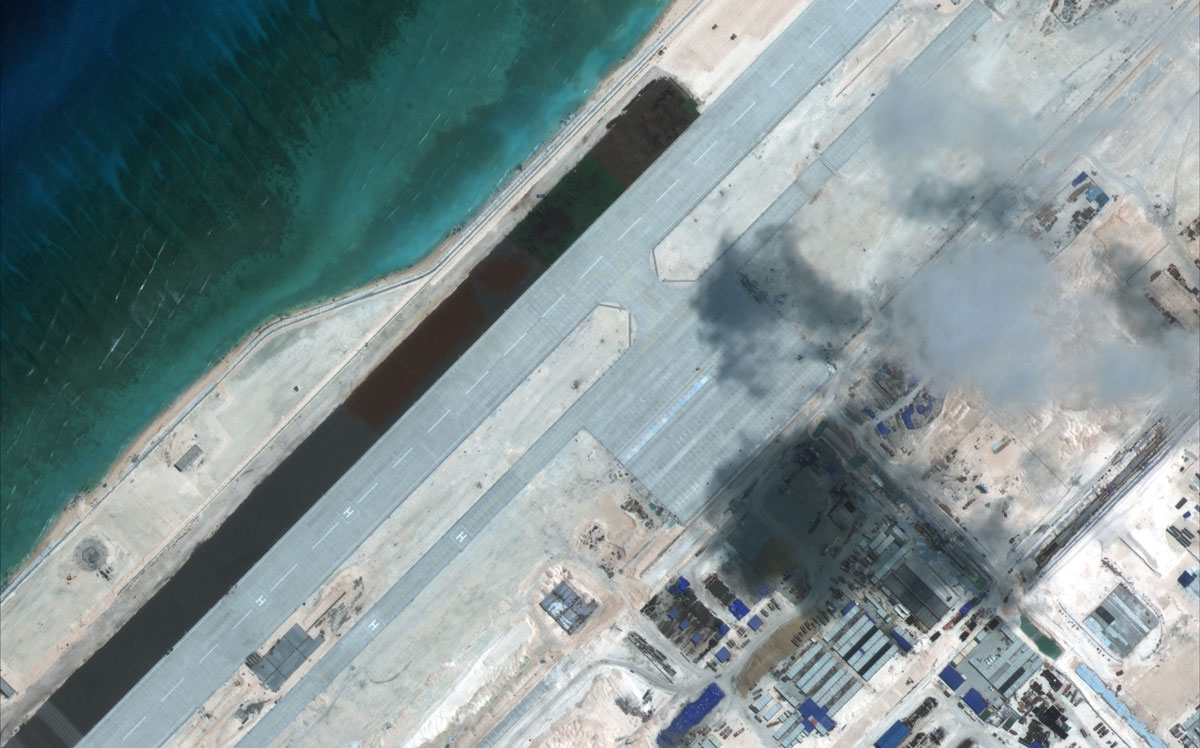Airpower Projection
Much attention has been paid to China’s new airstrip on Fiery Cross Reef. How does this runway compare to Malaysia’s on Swallow Reef, the Philippines’ on Thitu Island, Taiwan’s on Itu Aba, or Vietnam’s on Spratly Island? Below, explore infographics on each claimant’s airstrip size and the aerial operating range each enables. Watch an exclusive interview on China’s Fiery Cross runway with RAND Senior International Defense Analyst Timothy R. Heath. View satellite images of each Spratly airstrip and read more about the types of operations that each may enable.

Vietnam began construction of its airstrip on Spratly Island in 1976, making this the first runway in the Spratly island group. In 1978, the Philippines incorporated Thitu Island after airstrip construction had already begun. In 1983, Malaysia built a resort and airstrip atop Swallow Reef. The Nationalist Chinese government occupied Itu Aba in 1946, but did not begin constructing its airstrip until 2006, and construction finished in 2008. China is the most recent Spratly claimant to build an airstrip, which it began on Fiery Cross Reef in late 2014 after it reclaimed the former low-lying feature.
Vietnam’s Spratly Island airstrip is 550 meters long. The Philippines’ runway on Thitu Island is 1,000 meters long and unpaved. Malaysia’s Swallow Reef airstrip is 1,368 meters long. Taiwan’s recently-renovated runway is 1,195 meters long. China’s Fiery Cross airstrip measures 3,000 meters. Analysts have speculated that Beijing may also build a second airstrip on Subi Reef.
Maritime Surveillance Ranges in the South China Sea
From outposts in the South China Sea, claimants can conduct a variety of missions, including maritime patrol.

This graphic depicts the operational radii and ranges of each claimants’ maritime surveillance aircraft, assuming each takes off from its Spratly Island airstrip. An operational radius is the maximum distance an aircraft can travel from its base operations, accomplish some objective, and return to its original airfield. Range is the distance an aircraft can fly between takeoff and landing, as limited by fuel capacity.
A Chinese airbase at Fiery Cross Reef would allow for much-improved situational awareness and may permit China to deploy rotations of maritime surveillance aircraft. China may also use the base for training purposes and deploy fighter squadrons on a rotational basis. Located approximately 650 miles from China’s southernmost position at Hainan Island, China may be more readily able to use the airbase for patrols or limited offensive operations against other South China Sea claimants, or even United States assets.
RAND’s Timothy Heath discusses China’s airpower capabilities from Fiery Cross Reef.
Fiery Cross reef has a runway long enough to land a Chinese H-6G bomber, using runway requirements derived from the Russian Tu-16K, and assuming that the runway has been reinforced. A bomber like this could perform combat operations within 3,500 miles of the reclaimed reef. Fiery Cross would also be capable of landing and deploying the Chinese Shenyang J-11 fourth-generation fighter, using runway requirements derived from a Russian Su-27 fighter, which would be capable of combat operations within 870 miles of the reef.
New Island Imagery
Explore imagery of each claimant’s airstrip and read the details of what aircraft in its arsenal it could theoretically operate from the islands.

Taiwan’s Airstrip on Itu Aba
Itu Aba’s 1,195 meter airstrip is currently being upgraded, with work expected to finish by the end of 2015. The runway has an apron on either side. A runway of this length can accommodate a Taiwanese F-16 fighter, which has a combat radius of approximately 995 miles, a C-130 Hercules cargo plane, which has a range of 1,208 miles, and possibly even a P-3 maritime patrol craft, which has an operational radius of 1,549 miles.

Vietnam’s Airstrip on Spratly Island
Vietnam’s Spratly Island airstrip is approximately 550 meters long, not including an apparent extension that may have been made onto reclaimed land. It also has a small apron. A runway of this size can only accommodate small, low-tech surveillance planes such as the DHC 6-400, with a range of just 1,050 miles. It can also accommodate the Vietnamese Air Force’s M-28 light transport plane, which has a range of 863 miles.

Malaysia’s Airstrip on Swallow Reef
Malaysia’s Swallow Reef runway is 1,368 meters long and has two aprons. A control tower and hangars also stand nearby. The Swallow Reef airstrip theoretically allows Malaysia to land Sukhoi Su-30 fighter craft, which have a combat radius of 806 miles. They can also land C-130 Hercules cargo planes, which have an operational range of 1,208 miles.

The Phillippines’ Airstrip on Thitu Island
The Philippines’ Thitu Island airstrip is approximately 1,000 meters long. It is an unpaved, dirt surface with large, dirt aprons and is extremely worn. No major construction or engineering has been observed near this runway in recent years. The Thitu Island airstrip allows Manila to land C-130 Hercules cargo planes, as this video depicts, in addition to the OV-10 Bronco light attack craft, and BN-2A surveillance craft, which can patrol over 2,700 square miles per hour and has a flight endurance of about 8 hours. The C-130 has a range of 1,208 miles and the OV-10 has an operational range of 576 miles.
China’s Airstrip on Fiery Cross Reef
China is in advanced stages of construction on its 3,000 meter airstrip at Fiery Cross Reef. Beijing continues to pave and mark the airstrip, has added an apron, and is developing additional support facilities. Recent photos of Subi Reef suggest that China may also be preparing to lay down a second Spratly airstrip there, but no actual paving has been observed.
